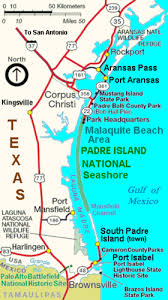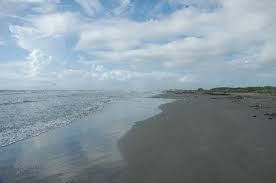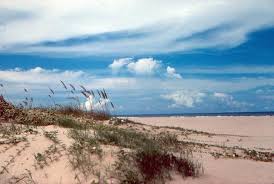For "Travel Tuesday":
Texas' Top Stretches of Sand

"Texas is known for a lot of things. However, many people overlooked the excellent beaches that are located along the Texas coast. With over 600 miles of shoreline, there is no shortage of sand for beachgoers. Here is a list of some of the top spots to spend day at the beach in Texas.
Corpus Christi/Padre Island National Seashore – The mainland portion of Corpus Christi is metropolitan. However, cross the causeway to Padre Island and the urban feel begins to fade. As you head south on Park Road 22 down Padre Island National Seashore, the modern world disappears.
Padre Island National Seashore stretches from Corpus Christi south some 75 miles to the Port Mansfield Cut - offering some of the most remote seashore to be found anywhere.
Stretching more than 70 miles, the Padre Island National Seashore, known locally as PINS, is the largest stretch of undeveloped barrier island beach in the world. Although it has no modern development other than a picnic shelter or two, visitors to PINS will find plenty to see and do. Fishing, camping, shell collecting, birding, swimming and surfing are just a few of the activities beachgoers can partake in on this islolated stretch of sand. During spring and summer, PINS is also home to a number of sea turtle nests.
--------------
Galveston Island – offers many beach-going options. Inside the city of Galveston, the seawall and adjacent sand strip is popular among visitors, as are Stewart Beach and East Beach. Further down the island, Galveston State Park and West Beach are favorite sandy hangouts. After a day of surf, sand and sun, head to the Strand to shop or visit one of Galveston’s many excellent eateries.
--------------
Mustang Island/Port Aransas – This quaint, central coast beach is located at the northern-most end of Padre Island. The ferry ride across to Port Aransas is a great way to leave the “real world” behind and begin your vacation. Things only get better as you visit Port A’s many shops and restaurants or stake out a secluded stretch of sand on Mustang Island.
---------------
Sea Rim State Park – A mix of marsh and beach, Sea Rim State Park isn’t a typical beach destination. However, this state park, which is located just south of Beaumont/Port Arthur is a nature-lover’s delight. Bird-watchers and beach-goers often co-exist on this stretch of sand, which is the northern-most beach in Texas. Great place to find shells.
---------------
South Padre Island – The most pristine beach in Texas is also the most difficult to get to. Located scant miles above the Mexican border, the South Padre surf is often a Caribbean-like clear/green as it laps against the grainy white sand. Across the Brazos Santiago Pass is isolated Boca Chica Beach. During your off-beach hours, try SPI’s sizzling nightlife, excellent restaurants and variety of curio shops. Other options include heading across the bridge to historic Port Isabel or across the border to Matamoros, Mexico.
Keep in mind, these are but a few of the beaches available in Texas. They are listed above in alphabetical order, not by any sort of rating, since they each have such diverse characteristics. But rest assured, whatever type of beach you have in mind can be found in Texas.
Free Texas Travel GuideThe Official Site of Texas Tourism. Order a Free Guide Now!www.TravelTex.com
_______________
Texas Parks and Wildlife Department- Palo Duro Canyon State Park
"The CCC History/Nature Hike is Saturday, Apr, 7 from 9:30-11:30. Meet at the Overlook Parking Lot for a guided hike to the floor of the canyon. No pets, please. Hike starts on time."
_____________
April 2, 2012 - "For many this week is looked on as "holy" because of the events observed. But what makes anything "holy"?" Transcript at: http://www.ucg.org/beyond-today-daily/doctrinal-beliefs/holy-week-really-holy
_____________
On This Day:
Pony Express debuts, Apr 3, 1860:
"On this day in 1860, the first Pony Express mail, traveling by horse and rider relay teams, simultaneously leaves St. Joseph, Missouri, and Sacramento, California. Ten days later, on April 13, the westbound rider and mail packet completed the approximately 1,800-mile journey and arrived in Sacramento, beating the eastbound packet's arrival in St. Joseph by two days and setting a new standard for speedy mail delivery. Although ultimately short-lived and unprofitable, the Pony Express captivated America's imagination and helped win federal aid for a more economical overland postal system. It also contributed to the economy of the towns on its route and served the mail-service needs of the American West in the days before the telegraph or an efficient transcontinental railroad.
The Pony Express debuted at a time before radios and telephones, when California, which achieved statehood in 1850, was still largely cut off from the eastern part of the country. Letters sent from New York to the West Coast traveled by ship, which typically took at least a month, or by stagecoach on the recently established Butterfield Express overland route, which could take from three weeks to many months to arrive. Compared to the snail's pace of the existing delivery methods, the Pony Express' average delivery time of 10 days seemed like lightning speed.
The Pony Express Company, the brainchild of William H. Russell, William Bradford Waddell and Alexander Majors, owners of a freight business, was set up over 150 relay stations along a pioneer trail across the present-day states of Missouri, Kansas, Nebraska, Wyoming, Colorado, Utah, Nevada and California. Riders, who were paid approximately $25 per week and carried loads estimated at up to 20 pounds of mail, were changed every 75 to 100 miles, with horses switched out every 10 to 15 miles. Among the riders was the legendary frontiersman and showman William "Buffalo Bill" Cody (1846-1917), who reportedly signed on with the Pony Express at age 14. The company's riders set their fastest time with Lincoln's inaugural address, which was delivered in just less than eight days.
The initial cost of Pony Express delivery was $5 for every half-ounce of mail. The company began as a private enterprise and its owners hoped to gain a profitable delivery contract from the U.S. government, but that never happened. With the advent of the first transcontinental telegraph line in October 1861, the Pony Express ceased operations. However, the legend of the lone Pony Express rider galloping across the Old West frontier to deliver the mail lives on today."
_______________
Yesterday:
Ray and I were going to put the last pieces of trim on the cargo trailer, but it started to rain, so we scrapped that. Jay was going to work on the trailer sink’s plumbing, but we didn’t want to track mud in there, so that was scrapped, too.
So, instead Jay and I moved my computer area out of it’s little dark, windowless corner, and moved it into my living room, right in front of the patio doors going to the screen porch. There, I can see the road in front of my house, and more importantly, the birds at the feeder. My laptop will stay where it was, to pay bills, as I don't want private papers in my living room.
We brought a square table down from the attic to fill in the space where the corner cabinet had been, to make the desk's view in just the right place. We only connected one computer, but it just wouldn’t get online. I reset the cable modem, router, all that jazz. When I returned from taking Jay home, Misty and Prime were looking at me, with a "something's wrong, Mom" look. It was too quiet. Then I realized that the TV was out, too. The water company had been digging, and cut the cable, again. So there I was on my laptop on ‘dial-up’, once more!
Ray car just suddenly went 'dead in the water', so I drove to where he was, but he had to call a wrecker.
Once the cable came back on, I found that my router wasn't getting power, so I had to switch Ethernet cords to the pc for "talking" in chat. I can type better on it than the laptop. Then the power went off, so I called it a day.























1 comment:
Sounds like you are having a tough time with utility services. Give up and take a nap!!
Post a Comment